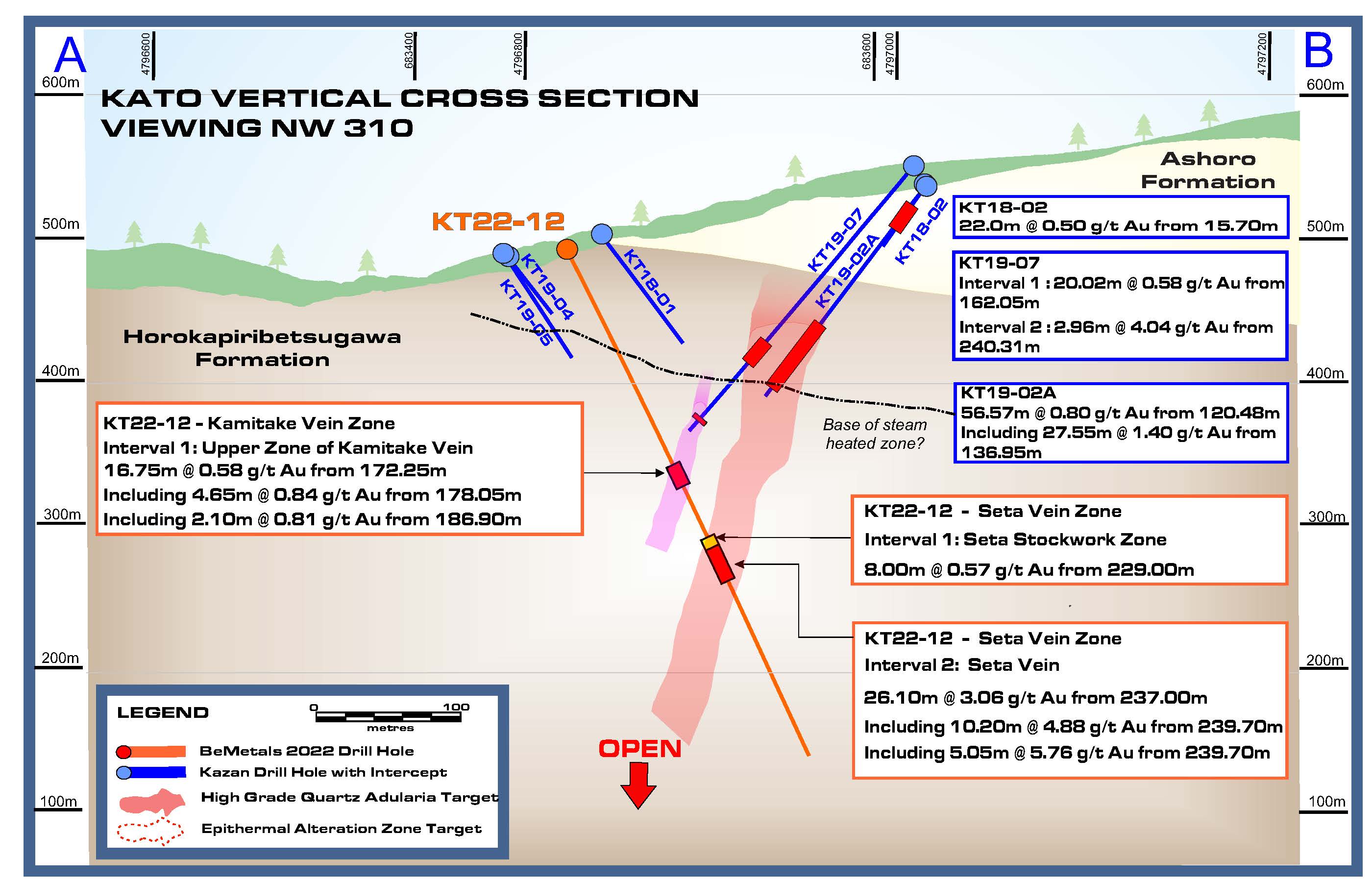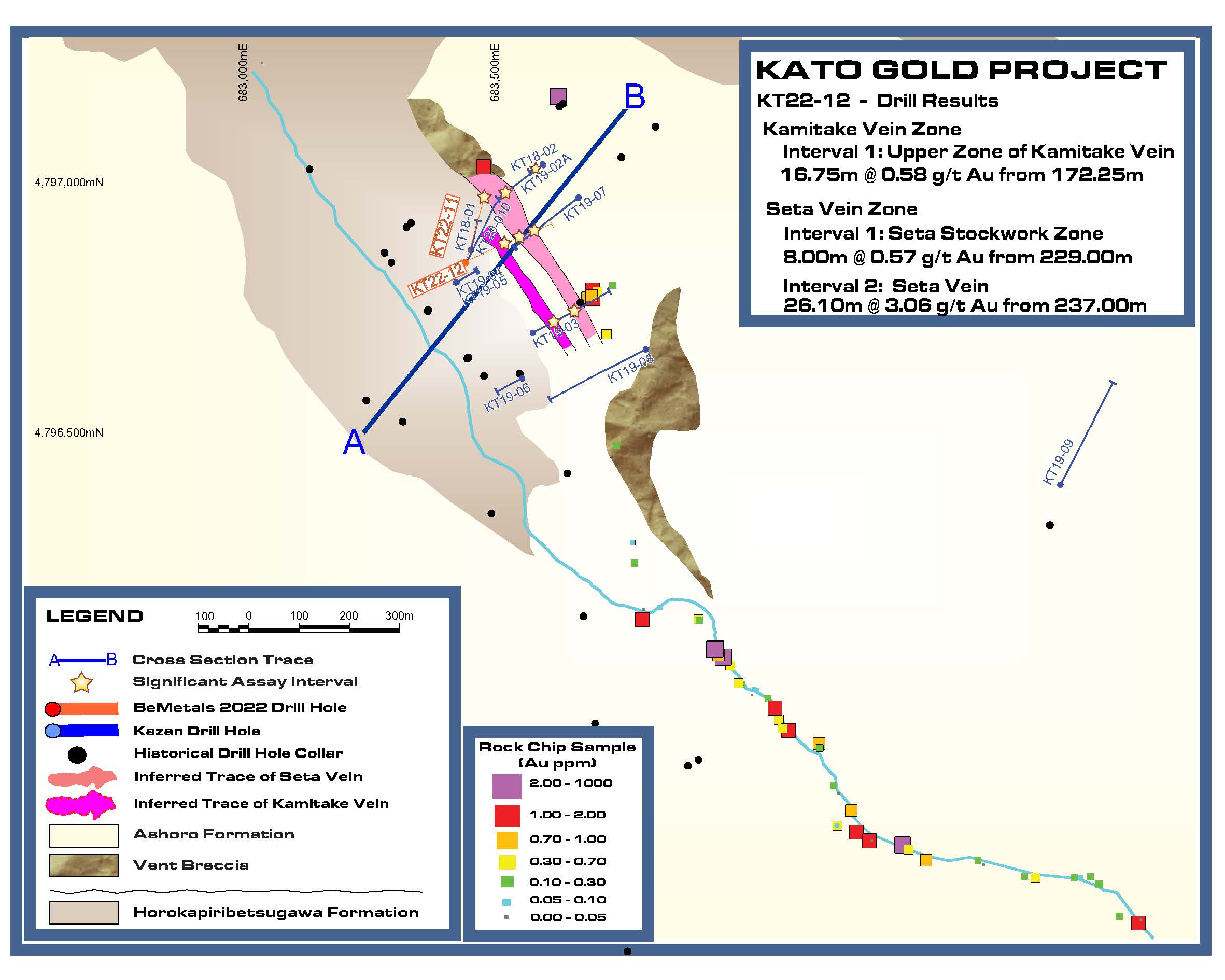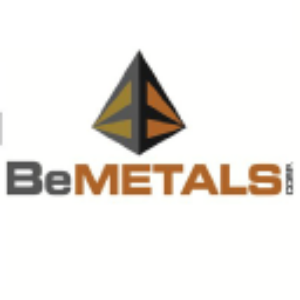BeMetals Extends Seta Vein and Identifies New Kamitake Vein Zone With Drilling Results at the Kato Gold Project in Japan
BeMetals Corp. has announced positive assay results from its drilling program at the Kato Gold Project in Hokkaido, Japan. The latest drill hole, KT22-12, showed significant gold intersections, including 26.10 metres grading 3.06 g/t Au in the Seta Vein Zone and 16.75 metres grading 0.58 g/t Au in the newly identified Kamitake Vein Zone. The company plans to expand its drilling campaign to 2,000 metres, aiming to further assess the potential of the gold system. Additional results are expected in the coming months.
- Drill hole KT22-12 reported 26.10 m grading 3.06 g/t Au in the Seta Vein Zone.
- Discovery of the Kamitake Vein Zone extends exploration potential.
- Drilling campaign increased to 2,000 metres based on successful results.
- KT22-12 only intersected 16.75 m grading 0.58 g/t Au in the Kamitake Vein Zone, indicating lower grade compared to Seta Vein.
Insights
Analyzing...
VANCOUVER, BC / ACCESSWIRE / September 21, 2022 / BeMetals Corp. (TSXV:BMET)(OTCQB:BMTLF)(Frankfurt:1OI.F) (the "Company" or "BeMetals") is pleased to announce assay results from its ongoing diamond drilling program at the Kato Gold Project ("Kato" or the "Property") in Hokkaido, Japan. Due to the continued success of the program, BeMetals plans to increase the size of its initial drilling campaign to 2,000 metres and will continue releasing more assay results in the coming months.
HIGHLIGHTS OF KT22-12 CORE DRILL HOLE:
- KT22-12: Seta Vein Zone: 26.10 metres ("m") grading 3.06 grams per tonne ("g/t") gold ("Au")
- Including: 10.20 m grading 4.88 g/t Au
- Including: 5.05 m grading 5.76 g/t Au
- KT22-12: Kamitake Vein Zone: 16.75 m grading 0.58 g/t Au
- This new hole extends the Seta Vein Zone by some 100 metres along strike from KT22-11
- The newly identified Kamitake vein, represents a significant additional target zone near the Seta Vein
- Additional drill hole assay results are expected to be released in the coming months
Note: Intertek Testing Services completed the analytical work with the core samples processed at their accredited laboratory in Manila, Philippines (See details in QA/QA section below). Reported widths are drilled core lengths as true widths are unknown at this time. Based upon current data it is estimated true widths range between 55 to
John Wilton, President and CEO of BeMetals stated, "We are pleased with these assay results from drill hole KT22-12 at our Kato Project on Hokkaido in Japan. This hole provides an approximate 100 metre extension to the strike length of the Seta Vein as intersected in the recently reported KT22-11 hole. These results demonstrate good continuity and scale potential of the Seta Vein as we continue our drilling program.
In addition to expanding the Seta Vein, KT22-12 has also intersected what is interpreted as the upper section of a newly recognised vein zone named the Kamitake Vein. This vein is only some 40 metres from the Seta Vein and future drill targeting will be planned to test Kamitake's potential grade, depth and strike extension. Both the Seta and Kamitake zones exhibit vein textures and other mineralogical features which are hallmarks of other typical epithermal gold deposits.
The results to date from drilling at Kato have motivated the Company to expand its current phase of drilling by approximately 500 metres to further test the scope, scale, and controls of this significant gold system."
KATO GOLD PROJECT DRILLING PROGRAM
This year, BeMetals plans to complete, a now expanded, approximately 2,000 metre drill program at the Kato Gold Project. The Company expects to continue to improve drilling progress with modifications to the hole designs and techniques that should provide constant geological exploration data and assay results.
Figure 1 illustrates the location of hole KT22-12 on a cross section in relation to the current simplified geological interpretation of this area at the Kato Project. It indicates the wide zone of gold mineralization in the Seta Vein and the close proximity of the newly identified Kamitake Vein zone. The observed increase in gold tenor from the historical shallower hole KT19-07 (20.02 m @ 0.58 g/t Au), in the steam heated zone of the system, to today's results reported from KT22-12 (26.10 m @ 3.06 g/t Au, including 10.20 m @ 4.88 g/t Au) could well be indicating higher gold grade continuity with depth. Such gold grade zonation is supported by textural and mineralogical observations within the veins.
Observations to date suggest that historical drilling has generally intercepted the epithermal system at shallow positions, hence there is significant potential to significantly extend the high-grade veins at depth and along strike.
Figure 1: Cross Section of Hole KT22-12 at Kato Gold Project

Note: Drill results of KT18-02, KT19-02A and KT19-07 are historical in nature and have been previously released in BMET news release dated July 28, 2021, and reported in the Company's technical report entitled, "Kato Gold Project Japan NI 43-101 Technical Report" with an effective date of July 13, 2021.
Table 1 below lists the gold intersections in hole KT22-12 which includes both the Seta and Kamitake Vein intersections and surrounding interpreted mineralized stockwork zones. Table 2 shows the details of KT22-12 with the hole; azimuth, dip, end of hole depth and collar coordinates.
Table 1: Drill Hole Intersection Results Hole KT22-12
Drill hole | From (m) | To (m) | Core Interval (m) | Au g/t | Comments |
KT22-12 | |||||
Seta Vein Zone: | |||||
Interval 1: | 229.00 | 237.00 | 8.00 | 0.57 | Seta Stockwork Zone (1) |
Interval 2: | 237.00 | 263.10 | 26.10 | 3.06 | Seta Vein |
| Including: | 239.70 | 249.90 | 10.20 | 4.88 | Seta Vein |
| Including: | 239.70 | 244.75 | 5.05* | 5.76 | Seta Vein |
Kamitake Vein Zone: | |||||
Interval 1: | 172.25 | 189.00 | 16.75 | 0.58 | Kamitake Vein Zone (1) |
| Including: | 178.05 | 182.70 | 4.65 | 0.84 | Interpreted Upper Zone of Kamitake Vein |
| Also Including: | 186.90 | 189.00 | 2.10 | 0.81 | Interpreted Upper Zone of Kamitake Vein |
Table 1 Notes: Intertek Testing Services completed the analytical work with the core samples processed at their accredited laboratory in Manila, Philippines (See details in QA/QA section below). Reported widths are drilled core lengths as true widths are unknown at this time. Based upon current data it is estimated true widths range between 55 to
(1) current interpretation.
Figure 2 is a simplified geological map illustrating the location of Hole KT22-12 and its reported drilled gold intersections. It shows the approximate 100m extension of the Seta Vein along strike from the previous intersection in drill hole KT22-11. Based upon current interpretation, the immediate target zones for further high-grade gold veins are indicated. It also shows the exploration potential with existing targets, to test the Kato gold system at significant distances to the southeast.
Figure 2: Location Map of Hole KT22-12 at Kato Gold Project

The Kato Project is located within a sparsely populated area of Hokkaido yet it is still in close proximity to infrastructure such as sealed roads and powerlines, and has access to supplies and services at the nearby town of Kamishihoro.
Table 2: Core Hole ID, Azimuth, Dip, End of Hole Depth and Collar Coordinates
Drill Hole ID | Azimuth Degree | Dip Degree | End of hole Depth (m) | Easting (m) | Northing (m) | Elevation (m) |
KT22-12 | 65 | -60 | 399.00 | 683422 | 4796857 | 494.72 |
THE KATO GOLD PROJECT
The Kato Gold Project is BeMetals' most advanced, of five exploration projects in Japan based on the amount of available historical drilling information, and the Property covers close to 2,000 hectares in central Hokkaido (See Figure 3). The Kato Project (historically referred to as the Seta River Prospect) is an example of a remarkably well-preserved epithermal gold system. Outcropping of clay-altered units are evidence of a high-temperature steam-heated zone above a hydrothermal gold plumbing system. This mineralization style is an example of a low-sulphidation epithermal system and the classic analogy for this mineralization type in Japan is the Hishikari Gold Mine, on Kyushu Island. Global examples of this type of mineralization include mines such as Lihir (Papua New Guinea), Kupol and Julietta (Russia), Waihi (New Zealand) and Masbate (Philippines).*
The Property was previously drilled by the Japanese state agency MMAJ in the 1990s and during that time results included high-grade intervals of gold such as 17.5 metres grading 8.15 g/t Au in hole 5MAHB-2 and 18.65 metres grading 5.01 g/t Au in hole 7MAHB-1.*
From 2018-2020, Kazan Resources ("Kazan"), acquired by BeMetals in 2021, drilled several holes at Kato that intersected a zone of hydrothermal breccia near the adjacent main alteration target vein. Their results included hole KT19-02A which returned a number of zones of gold mineralization such as 14 metres grading 2.10 g/t Au.* In 2020, drilling intersected over 50 metres of clay alteration, hydrothermal breccia, vein breccia, stockwork, and banded quartz-adularia low sulphidation epithermal veins in hole KT20-010. That hole intersected 58.9 metres grading 0.76 g/t Au, including 7.4 metres at 2.99 g/t Au, and ended in 2.8 metres grading 3.1 g/t Au.* Due to a lack of inserted bore hole casing the hole was lost in a mineralized zone and is thought to have not intersected the high-grade vein target.
*Please refer to technical report entitled, "Kato Gold Project Japan NI 43-101 Technical Report" with an effective date of July 13, 2021.
Figure 3. Location of BeMetals Gold Projects in Hokkaido, Japan

QUALITY ASSURANCE AND QUALITY CONTROL
The new results reported here for this core drilling program were analyzed by Intertek Testing Services, an independent and accredited laboratory. Samples were prepared and analytical work conducted in Manila, Philippines. The results were obtained using the following analytical methods as appropriate to determine the gold grades; FA50N/AA of 50g fire assay, with Atomic Absorption Spectrometry ("AAS") finish and FA50GR/GR of 50g fire assay with Gravimetric finish for over limit samples exceeding 10 g/t Au. The core sampling was conducted with a robust sampling protocol that included the appropriate insertion of standard reference material, duplicates, and blanks into the sample stream.
Field operations and management have been conducted by BeMetals' personnel. The core drilling was conducted by Energold Drilling.
ABOUT BEMETALS CORP.
BeMetals is a precious and base metals exploration and development company focused on becoming a leading metal producer through the acquisition of quality exploration, development and potentially production stage projects. The Company has established itself in the gold sector with the acquisition of a portfolio of wholly owned exploration projects in Japan. BeMetals is also progressing both its tier-one targeted, Pangeni Copper Exploration Project in the prolific Zambian Copperbelt, and advancing its high-grade, zinc-silver-gold-copper exploration at the South Mountain Project in Idaho. Guiding and leading BeMetals' growth strategy is a strong board and management team, founders and significant shareholders of the Company, who have an extensive proven record of delivering exceptional value in the mining sector, over many decades, through the discovery, construction and operation of mines around the world.
QUALIFIED PERSON STATEMENT
The technical information in this news release for BeMetals has been reviewed and approved by John Wilton, CGeol FGS, CEO and President of BeMetals, and a "Qualified Person" as defined under National Instrument 43-101.
ON BEHALF OF BEMETALS CORP.
"John Wilton"
John Wilton
President, CEO and Director
For further information about BeMetals please visit our website at bemetalscorp.com and sign-up to our email list to receive timely updates, or contact:
Derek Iwanaka
Vice President, Investor Relations & Corporate Development
Telephone: 604-928-2797
Email: diwanaka@bemetalscorp.com
Neither the TSX Venture Exchange nor its Regulation Services Provider (as that term is defined in the policies of the TSX Venture Exchange) accepts responsibility for the adequacy or accuracy of this news release
Cautionary Note Regarding Forward-Looking Statements
This news release contains "forward-looking statements" and "forward looking information" (as defined under applicable securities laws), based on management's best estimates, assumptions and current expectations. Such statements include but are not limited to, statements with respect to future exploration, development and advancement of the South Mountain Project, the Pangeni project and the Japan properties, and the acquisition of additional base and/or precious metal projects. Generally, these forward-looking statements can be identified by the use of forward-looking terminology such as "expects", "expected", "budgeted", "forecasts", "anticipates", "plans", "anticipates", "believes", "intends", "estimates", "projects", "aims", "potential", "goal", "objective", "prospective", and similar expressions, or that events or conditions "will", "would", "may", "can", "could" or "should" occur. These statements should not be read as guarantees of future performance or results. Such statements involve known and unknown risks, uncertainties and other factors that may cause actual results, performance or achievements to be materially different from those expressed or implied by such statements, including but not limited to: the actual results of exploration activities, the availability of financing and/or cash flow to fund the current and future plans and expenditures, the ability of the Company to satisfy the conditions of the option agreements for the South Mountain Project and/or the Pangeni Project, and changes in the world commodity markets or equity markets. Although the Company has attempted to identify important factors that could cause actual results to differ materially from those contained in forward-looking statements, there may be other factors that cause results not to be as anticipated, estimated or intended. There can be no assurance that such statements will prove to be accurate, as actual results and future events could differ materially from those anticipated in such statements. The forward-looking statements and forward looking information are made as of the date hereof and are qualified in their entirety by this cautionary statement. The Company disclaims any obligation to revise or update any such factors or to publicly announce the result of any revisions to any forward-looking statements or forward looking information contained herein to reflect future results, events or developments, except as require by law. Accordingly, readers should not place undue reliance on forward-looking statements and information. Please refer to the Company's most recent filings under its profile at www.sedar.com for further information respecting the risks affecting the Company and its business.
SOURCE: BeMetals Corp.
View source version on accesswire.com:
https://www.accesswire.com/716787/BeMetals-Extends-Seta-Vein-and-Identifies-New-Kamitake-Vein-Zone-With-Drilling-Results-at-the-Kato-Gold-Project-in-Japan







